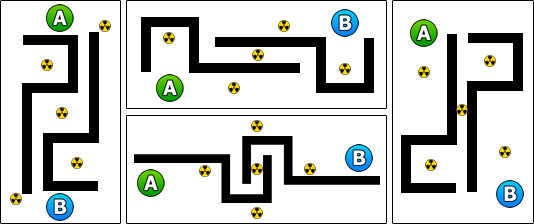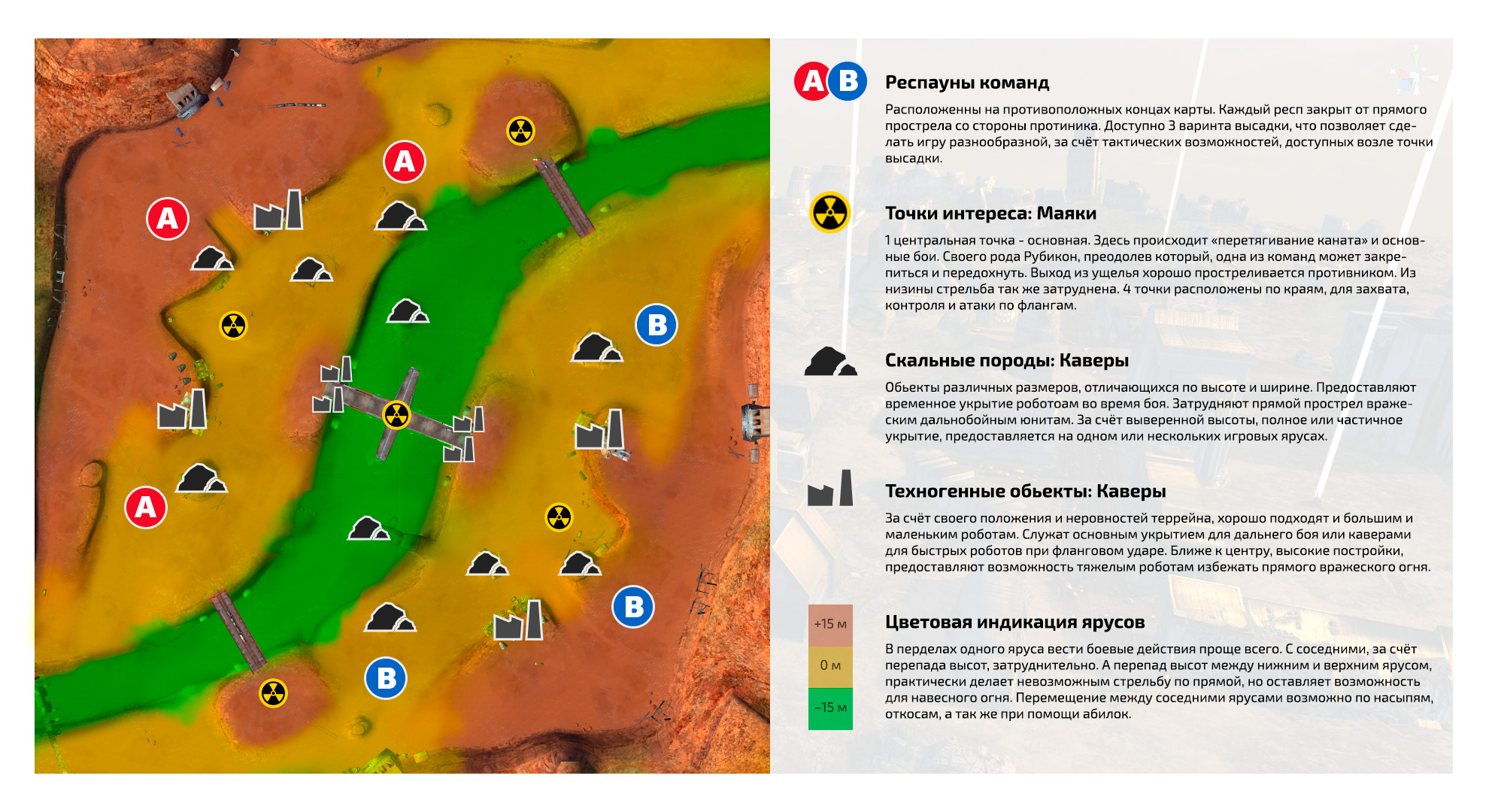Pitfalls of the level design of mobile MMO shooters
How to create multiplayer maps for mobile shooters correctly, where to start, what tricks to resort to, and what to remember — App2Top.ru told Pixonic game designer Alexander Linchik.

Creating maps for games of various genres has its own peculiarities. We were convinced of this during the development of our own project Walking War Robots. Over the years of development, we have accumulated experience in creating new maps, and I decided to share the basic principles of creating locations for MMO shooters.
Decide on the available options
Before you start planning a location, you should familiarize yourself with the gameplay features that will be provided to users in the game. In addition, write down, or better yet, remember the key metrics. In our case, such metrics included not only the speed of movement of robots, their classes and sizes, but also the attack distances of weapons and skills. It is focusing on the opportunities that are available to the player that the level should be designed.
Test in an empty space
While you are collecting and studying metrics, create a “testing ground” and place objects of various sizes on it, as well as planes for testing gaming capabilities. In Walking War Robots, this allowed us to save a lot of time by understanding the possibilities and their interaction with the environment — the height of the jump, the size of shelters for effective protection of robots of all sizes, types of inclined surfaces (on which you can move), and not slide.
The metrics of the weapon made it possible to create a set of “lines” to determine the effective attack distance and helped plan points of interest, shooting and territory control.
Level geometry

After understanding the possibilities of the game, a set of templates and limitations, it’s time to think about creating the geometry of the location. One of the classic techniques when creating a level geometry is the use of symmetry. By the way, chess is an ideal example — if you look at the chessboard, you will easily find symmetry: both players have equal conditions for conducting a competition. A map, a board or a field in the case of other traditional types of games or sports does not help or interfere with the game in any way.
Stick to this when building levels for PVP battles, unless you create a special mode for territory control, capture/defense or something similar. Otherwise, instead of fighting with the enemy, one of the players or the whole team will be forced to fight with the location — it will quickly get boring.
Be sure to keep a balance between open and closed spaces, as well as place objects and shelters, taking into account their usefulness to the player and the possibility of countering them. No point on the location can be absolutely safe and must constantly keep the player in suspense.
Don’t fill all the available game space with objects, focus on the key areas. Avoid unnecessarily large locations that require a long rapprochement with the enemy, they cause irritation. The player comes to have fun, which means long and meaningless walks around the location are corny boring.
On the other hand, it’s bad when the fight starts too quickly. The player does not have time to orient himself in what is happening, make a decision and have time to implement it. And in this case, there is a danger of being locked in the drop zone. The optimal distance can be considered the one at which the time to fire contact does not exceed 10-15 seconds.
During this time, the player will have time to assess the situation and come up with a certain strategy, focusing on their own preferences and capabilities, as well as on the composition of the team and the direction of movement. Of course, it is worth adjusting for the speed of the characters, their abilities or gameplay features.
It is important to know the technical limitations and achieve the optimal ratio of the saturation of the location and its performance. To do this, allocate the available resources based on your vision of the future location. Somewhere you can pay more attention to the coin, somewhere you can increase the number of objects. Focus on the gameplay component. Bad graphics can be forgiven, but not bad gameplay. Even ultra realistic graphics won’t keep people from boring gameplay — they will start leaving the game.
Equal opportunities for all teams
Regardless of the geometry, the capabilities of the teams should be equal. To achieve the best results, you can use not only objects, but also level irregularities. In open areas, rocks, hills, riverbeds, channels, cliffs, bridges and other height differences will help create a diverse gameplay and add realism to what is happening.
The exception is fighting indoors or at city levels — small enclosed spaces often suggest a more dynamic and no less tactful mechanics of the game. A different approach is needed here.
Level symmetry as a solution
As I said above, it is important to give equal conditions to players or compensate for this with additional opportunities. When creating a map with equal opportunities, mirroring the location of objects on the location, using multi—tiering with the use of height differences, various types of shelters and the presence of workarounds, the number of which is based on the number of team players, can be an excellent solution to the balance problem.
At the same time, the symmetry of the location may or may not be obvious. This can be direct mirroring, axial, axial with offset, in some cases there may be several non-obvious mirroring axes.
The multi-tiered location will save resources for objects and saturate the location with interesting features due to the terrain. For example, at the Canyon location, we used multi—tiering and mirroring – each tier represents the playing field, and the player can independently choose where and how to fight. The location of objects on the location is also symmetrical, and if a sniper is playing, then the location of sniper positions for both teams is the same and equally covers the area of responsibility.
Add dynamics through “measures-countermeasures”
When creating It is important to think over the gameplay of the “skeleton location” by making such mechanics that any action will generate opposition from the enemy — this is a very important aspect. Conditionally, it can be called a “measure-countermeasure”.
It is not necessary that the counteraction should occur in the direction of the attack. By strengthening one of the directions, you can weaken the other, for example, due to the small number of shelters suitable for small and fast robots. This will allow them to make a flanking detour, preventing heavy robots from firing effectively.
It is quite possible that by capturing an object, the players of one of the teams are fixed on it, so the enemy needs to knock them out of position or take a similar one elsewhere. But at the same time, there will remain undisguised flanks or other ways of circumvention / penetration, allowing the enemy to come up with and implement a tactical trick.
Such tricks fundamentally affect the pattern of the battle, repeatedly changing tactics, strategy and motivation of behavior. Try to take into account the psychology of the player in the construction of the location. Let the scout find narrow streets and corridors for flanking, stormtroopers break through enemy lines in a straight line, and snipers cover them or conduct a positional war.
This leads to the next important aspect — it is worth giving players as many opportunities as possible to implement their ideas, ideas. Let them show cunning and ingenuity, come in from the flanks, strike unexpected blows and take advantage of the class and available skills. But don’t slide into a full sandbox — it gets too boring.
The symmetry of the location can be smoothed by applying various visual effects. For example, the same gameplay object located in different parts of the location can become a cargo container, bus, tank, building or rock. You can also use a broken line of symmetry.
Try to use the possibilities of the landscape — work not in one plane, but in all three dimensions. The height of the objects regulates the shooting range well, providing additional tactical opportunities for “jumping” characters.
The most important thing is to combine game features. The approach to the same point can be through an overpass bridge, an underground tunnel, or even a riverbed. Mechanically, these sections will be equivalent, but visually they are not. A lowland, plus a low house can give a good shelter, but it is worth trying to leave the lowland, and the house will no longer be a shelter.
Collect feedback
After creating a playable prototype, it should be tested in conditions as close to real as possible. Which type of testing to choose, internal or external, is not so important.
But getting feedback and information about shortcomings is critical. Therefore, always take criticism as a tool to make the location even better and more interesting. Everyone will benefit from this.



